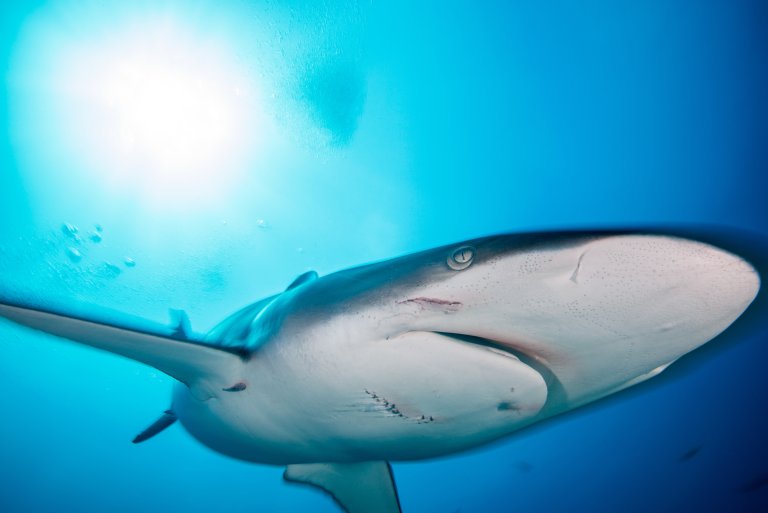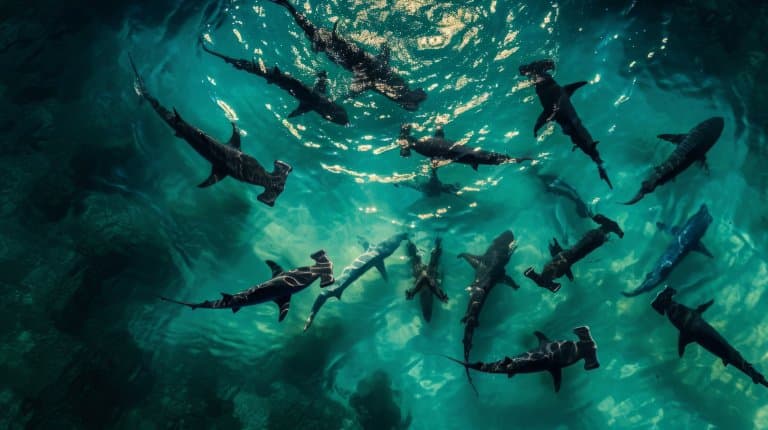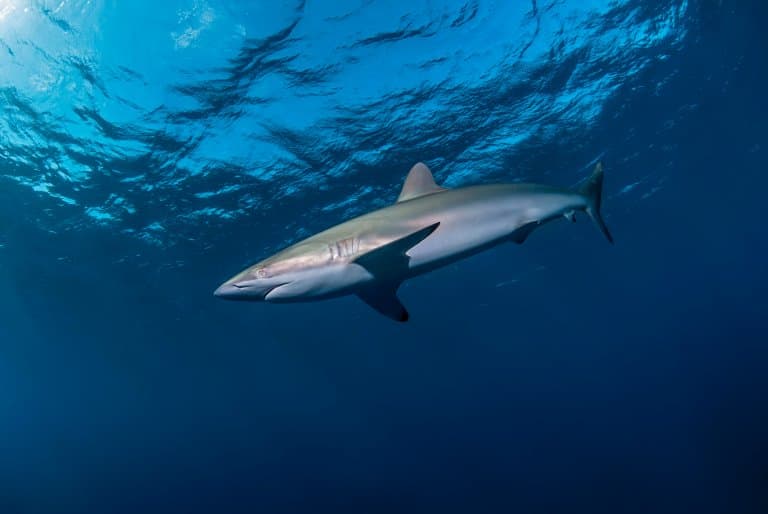Silky Shark Profile
It bears repeating that the requiem sharks are the sexiest of all sharks. This is a family of sharks that includes the wolflike blacktip reef shark, the ever-sultry dusky shark, the alluringly intimidating bull shark and the gorgeous-but-dim (-looking) blue shark.
So, it’s no surprise that there’s one named after the material used to make bedsheets in a classic boudoir. The silky shark lives up to its name as a beautiful and elegant murderer of pelagic teleosts.
The silky shark is known by many names, including the blackspot shark, sickle shark, ridgeback shark, gray whaler shark, and ‘net-eating’ shark. They are abundant around the world in tropical waters.

Silky Shark Facts Overview
| Habitat: | Open ocean, photic zone |
| Location: | Warm and temperature waters worldwide, |
| Lifespan: | 25 years |
| Size: | Maximum of 3.5 m (11 ft) |
| Weight: | Up to 346 kg (763 lb) |
| Colour: | Bronze-grey on top, creamy white beneath |
| Diet: | Opportunistic predators of bony fish, often tuna |
| Predators: | Orca, larger sharks, humans |
| Top Speed: | Unknown |
| No. of Species: | 1 |
| Conservation Status: | Vulnerable (IUCN) |
Silkies are one of the most common sharks in the oceans and were once thought to be undepletable. Sadly, like everything that humans think will never run out, they’re declining rapidly!
They were reclassified as vulnerable in 2017 by the IUCN which assess conservation status.
They are inquisitvie and aggressive predators and feed predominantly on bony fish, and will often ‘herd’ schools of tuna to feed in groups.
These are one of the most significant species of large predator in the ocean, due to their long-distance migrations, huge number and diverse feeding habits. And they have a lot left to teach us!
Interesting Silky Shark Facts
1. Net-eating sharks
Silky sharks, as we’ve established, are requiem sharks, in the Carcharhinidae family. They’re sleek, agile, middle-sized predators with long pectoral fins, characteristic of pelagic, or open-water, sharks.
Their skin, like all sharks, is covered in dermal denticles, or tooth-like structures, which in this species are particularly small, giving the animal the sheen after which it’s named. But it has other names, too, one of which is the net-eating shark, on account of its habit of ransacking tuna nets and stealing the fish.
This is one of the most common sharks in the oceans, and therefore the species gets through a lot of fish, sharing its prey species with another of the ocean’s top predators, the dolphins. 1

2. They compete with dolphins
Competition is harder to document in the ocean, especially in pelagic species, that move around a lot and aren’t as considerate towards behaviourists as their sedentary, shallow-water relatives.
But there’s enough action within reach of human cameras to do some research, and some of this is showing us the way that dolphins and sharks interact on ecological scales. When the two species share a school of fish, dolphin intake drops in relation to the number of sharks that are present.
At the beginning of a feeding event, if there are many sharks present, the dolphins will try to match or exceed their number, which can in turn result in fewer sharks showing up.
It appears that the dolphins may be worried about getting into fights with the sharks and choose to go elsewhere, but they also sometimes have the numbers to intimidate the sharks to some extent. 2
3. They’re friends with hammerheads
A much more amicable relationship seems to be between the silkies and the scalped hammerheads, who are seen together quite often.
Spotted in shark hotspots like the Galapagos, silkies and hammerheads congregate in large numbers, where there is no sign of competition, and the two species seem content in one another’s company.
They appear to have social behaviours that nobody yet understands. Large migratory groups are often segregated by sex and can be a great place to see the species interacting. Some will display their sides to one another, others will rush up to the surface suddenly. Sometimes they will gape their mouths at one another.
But between these social events, the sharks appear to go off on mysterious, long-distance journeys. Researchers are still trying to uncover some of these mysterious trips and understand the reason why some sharks make them while others don’t. 3

4. They have strange teeth
The upper and lower teeth in these sharks don’t look much alike. The top rows are wide, serrated triangles like you see in mammal-eating sharks, while the lower teeth are slimmer, smooth and piercing, as you see in the fish eaters.
This gives the shark the best of both worlds and allows it to eat large fish like tuna. Wide, serrated teeth are great for cutting flesh, and the lower needle-like grippers can catch and hold onto their kill. 4
5. They have great hearing
Aside from being excellent at biting, they can do a fair bit of hearing, too. Silky sharks are highly sensitive to low-frequency sound, to which they appear to be attracted.
It’s thought that these low rumbles, tested using irregular pulses, sound like distant feeding frenzies of other hunters like dolphins and can draw in silkies from hundreds of meters away.
But they’re also skittish. If the sound changes abruptly, they’ll quickly change course and withdraw from the pursuit.

6. They’re important hunters
Being such a widespread and abundant opportunistic predator, these sharks take a lot of food out of the ocean, mostly in the form of bony fish.
They’ve been known to scavenge from whale carcasses and take crustaceans too, but are skilled enough at hunting that they can herd fish into bait balls, after which they can each dart in and impale their snacks.
The sheer amount of these sharks and the diversity of their prey make them ecologically significant across the oceans they inhabit.
7. Silky sharks are viviparous
This means the embryo is developed inside the body of the mother through a placental connection.
Silky sharks will give birth to litters of between 6-12 pups every year, or every other year and the gestation period of 12 months.
8. There are a lot of them
This species is in the top three most common pelagic sharks, along with blue sharks and oceanic whitetips, both close cousins of the silky. There are thought to be tens of millions of these sharks in the oceans, and while they are pelagic, they spend more time in the coastal waters than the other two species, so they come into contact with humans more.
They’re curious and interact with their environments, and are often seen around floating objects, checking them out.
The abundance of this shark led to it being considered entirely incapable of depletion, even though millions are killed each year. This turned out to be false.
9. But they’re decreasing all the time
As a species of shark, the silky is part of the “hundreds of millions” statistic, of sharks killed annually by the fishing industry by mistake.
As such, it’s no surprise that it’s threatened by overfishing, but it’s also disproportionally so, as the second-most caught shark species. Most catches are just a side effect of the relentless and indiscriminate harvesting of the ocean by the international fishing industry, but some are targeted too.
Their long fins are sought after for ridiculous soups and the use of Fish Aggregating Devices known as FADs affect their behaviour and diet and lead to more of them getting tangled in nets. 5
10. They are potentially dangerous to humans
Due to it’s size, inquisitive and aggressive nature, they are considered potentially dangerous to humans in the water. They have been recorded approaching divers out of curiosity.
However, as of 2009, the International Shark Attack File only includes 6 attacks attributable to the silky shark. Three of them were unprovoked, and none of them have been fatal.

Silky Shark Fact-File Summary
Scientific Classification
| Kingdom: | Animalia |
| Phylum: | Chordata |
| Class: | Chondrichtyes |
| Order: | Carcharhiniformes |
| Family: | Carcharhinidae |
| Genus: | Carcharhinus |
| Species: | Carcharhinus Falciformis |
Fact Sources & References
- “Carcharhinus falciformis”, Florida Museum.
- Alejandro Acevedo-Gutierrez (2002), “Interactions between marine predators: Dolphin food intake is related to number of sharks”, Research Gate.
- “Uncovering the secret movements of silky sharks”, Save Our Seas.
- Cheryl D Wilga, “Teeth of silky shark Carcharhinus falciformis”, Research Gate.
- “Silky Shark”, IUCN Red List.
